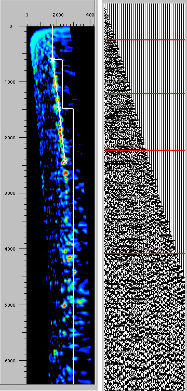Anisotropic Earth Models
Estimating an anisotropic Earth model is not easy. In the best case, the seismic data on which anisotropic parameters are based contain the necessary information to facilitate accurate velocity estimation. However, since this is not likely to be the case, we must make do with what we have.
Figure 1(a) is a graphic of why normal seismic velocity analysis does not generally provide an Earth model suitable for accurate depth imaging. The blue ray fronts indicate that the lateral velocity is faster than the vertical velocity shown in magenta. Semblance analysis tends to produce estimates of the lateral velocity variation and not the vertical variation. That is, in the specified Earth model used to compute the ray fronts, the magenta ray fronts are not present, so when velocities are estimated, the resulting interval velocity will be more proportional to the faster lateral sound speed. So long as we use a short spread analysis, as specified by Figure 1(b), our Earth model velocity field will be too fast. Nevertheless, it normally provides us with excellent images and a velocity field that can be used to estimate δ in conjunction with a suitable well field.


